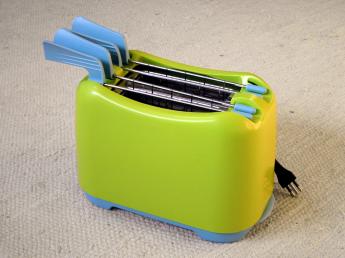Toaster
|
|
A toaster is a machine for toasting food such as sliced bread and bagels. Toasted bread is called toast. Other toastable products may be described as toaster pastry.
A typical toaster uses infrared radiation to heat a piece of bread. The heat is usually produced by conducting electricity through nichrome wires (Joule heating). The toasting process consists of reducing the bread's water content (originally ~35% of total weight), raising its temperature, and slightly charring and caramelizing its surface. The caramelization process is a chemical reaction in which the complex starch molecules break apart into simpler sugar molecules upon heating. That is why toast is usually sweeter than normal bread.
Toaster ovens perform toasting functions of a pop-up toaster, however, the heating elements are positioned horizontally. A toaster oven usually has a glass door and a pull out tray upon which the object to be toasted is placed. Because of its design, a toaster oven can also perform some of the functions provided by a regular oven, but on a somewhat smaller scale.
| Contents |
Energy consumption
A typical modern 2-slice toaster operates on anywhere between 600-1200 W and makes toast in 1-3 minutes.
Rough calculations for the energy required to toast a slice of bread:
- A slice of bread weighs about 32 g or about .10 oz. and has about 35% water.
- The ambient temperature is 25 °C or 77 °F.
- The specific heat for dry bread is about the same as water, which is 1 cal/g °C.
- Reducing the average water content to 10% by heating the bread to 100 °C --> 28 kJ
- Energy to char the surface is assumed to be insignificant.
History of toasters
GE released an electric toaster in 1909, patented under the name D-12. It is widely thought to be the first electric toaster on the market, but there is some controversy. An ad for the Pacific Electric Heating Company's competing Hotpoint brand toaster ran in the Saturday Evening Post in 1917, claiming:
- Perhaps you didn't know that the very first toaster made was a Hotpoint. That was 12 years ago. [1] (http://www.toaster.org/hotpoint.html)
That ad places the Hotpoint's introduction in 1905, the very year Albert Marsh developed Nichrome wire. Nichrome could endure a suitable high heat for a long time, and the discovery of such a filament had been the linchpin of electric toaster development.
The pop-up toaster, which ejects the toast after toasting it, was patented by Charles Strite in 1919.
In 1925, using a redesigned version of Strite's toaster, the Toastmaster Company began to market the first household toaster that could brown bread on both sides simultaneously, set the heating element on a timer, and eject the toast when finished. By 1926, Charles Strite's Toastmaster was available to the public and was a huge success.
More recent additions to toaster technology include the ability to toast frozen bread, a mode to toast the cut side of a bagel only, separate operation levers to allow users to toast either two or four slices, and reheating functions which allow toast to be warmed without being burned.
Related article
External links
- The Toaster Museum (toaster.org) (http://www.toaster.org/museumintro.html): A detailed site devoted entirely to toasters and their history
- The German Toaster Museum (toasters.de) (http://www.toasters.de): A nice, informative site devoted entirely to toasters and their history
- History of the Toaster - Gizmohighway Technology Guide (http://www.gizmohighway.com/pages/history/toaster.htm)
- History of the electric toaster (http://www.bergen.org/AAST/Projects/Engineering_Graphics/_EG2001/toasterama/toasterhistory.html)
- How Toasters Work (Howstuffworks.com) (http://www.howstuffworks.com/toaster.htm)de:Toaster
es:Tostadora fr:Grille pain nl:Broodrooster pl:Toster sv:Brödrost

